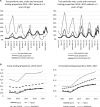How Far Are We from Reaching Universal Malaria Testing of All Fever Cases?
- PMID: 29943717
- PMCID: PMC6169169
- DOI: 10.4269/ajtmh.18-0312
How Far Are We from Reaching Universal Malaria Testing of All Fever Cases?
Abstract
Universal malaria diagnostic testing of all fever cases is the first step in correct malaria case management. However, monitoring adherence to universal testing is complicated by unreliable recording and reporting of the true number of fever cases. We searched the literature to obtain gold-standard estimates for the proportion of patients attending outpatient clinics in sub-Saharan Africa with malarial and non-malarial febrile illness. To correct for differences in malaria transmission, we calculated the proportion of patients with fever after excluding confirmed malaria cases. Next, we analyzed routine data from Guinea and Senegal to calculate the proportion of outpatients tested after exclusion of confirmed malaria cases from the numerator and denominator. From 12 health facility surveys in sub-Saharan Africa with gold-standard fever screening, the median proportion of febrile illness among outpatients after exclusion of confirmed malaria fevers was 57% (range: 46-80%). Analysis of routine data after exclusion of confirmed malaria cases demonstrated much lower testing proportions of 23% (Guinea) and 13% (Senegal). There was substantial spatial and temporal heterogeneity in this testing proportion, and testing in Senegal was correlated with malaria season. Given the evidence from gold-standard surveys that at least 50% of non-malaria consultations in sub-Saharan Africa are for febrile illness, it appears that a substantial proportion of patients with fever are not tested for malaria in health facilities when considering routine data. Tracking the proportion of patients tested for malaria after exclusion of the confirmed malaria cases could allow programs to make inferences about malaria testing practices using routine data.
Figures





References
-
- World Health Organization , 2010. Guidelines for the Treatment of Malaria, 2nd edition. Geneva, Switzerland: WHO.
Publication types
MeSH terms
LinkOut - more resources
Full Text Sources
Other Literature Sources
Medical

